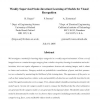Free Online Productivity Tools
i2Speak
i2Symbol
i2OCR
iTex2Img
iWeb2Print
iWeb2Shot
i2Type
iPdf2Split
iPdf2Merge
i2Bopomofo
i2Arabic
i2Style
i2Image
i2PDF
iLatex2Rtf
Sci2ools
107
click to vote
IJCV
2007
2007
Weakly Supervised Scale-Invariant Learning of Models for Visual Recognition
We investigate a method for learning object categories in a weakly supervised manner. Given a set of images known to contain the target category from a similar viewpoint, learning is translation and scaleinvariant; does not require alignment or correspondence between the training images, and is robust to clutter and occlusion. Category models are probabilistic constellations of parts, and their parameters are estimated by maximizing the likelihood of the training data. The appearance of the parts, as well as their mutual position, relative scale and probability of detection are explicitly described in the model. Recognition takes place in two stages. First, a feature-finder identifies promising locations for the model’s parts. Second, the category model is used to compare the likelihood that the observed features are generated by the category model, or are generated by background clutter. The flexible nature of the model is demonstrated by results over six diverse object categori...
Related Content
| Added | 15 Dec 2010 |
| Updated | 15 Dec 2010 |
| Type | Journal |
| Year | 2007 |
| Where | IJCV |
| Authors | Robert Fergus, Pietro Perona, Andrew Zisserman |
Comments (0)

